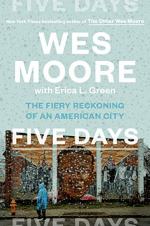|
This section contains 726 words (approx. 2 pages at 400 words per page) |

|
Five Days Summary & Study Guide Description
Five Days Summary & Study Guide includes comprehensive information and analysis to help you understand the book. This study guide contains the following sections:
This detailed literature summary also contains Topics for Discussion on Five Days by Erica L. Green and Wes Moore .
The following version of this book was used to create this study guide: Moore, Wes and Green, Erica L. Five Days: The Fiery Reckoning of an American City. New York: One World, 2020.
Five Days: The Fiery Reckoning of an American City, centers on the protests and social unrest in Baltimore following the police killing of Black resident Freddie Gray. The book follows the real-life experiences of numerous individuals during that time. Additionally, the book exposits upon the characters’ overall life experiences, as well as detailing relevant social, political, and economic contexts. The book seeks not only to provide accounts from those days of unrest, but also to explore the relevant dynamics of racism and inequality that shape Baltimore and America in general.
One person that the book follows is Tawanda Jones, a Black resident of Baltimore who works as a teacher. In 2013, police unjustly killed her brother, Tyrone West. The police then proceeded to suppress evidence of the true nature of Tyrone’s death. Tawanda became a persistent activist, both for her brother’s case, and against police brutality in general. Tawanda participated in the protests following Freddie Gray’s death. She eventually managed to uncover the suppressed evidence of police violence against her brother. Although the police officers were never indicted, she did win a monetary settlement from the city in a civil suit.
Billy Murphy is a Black lawyer and social justice activist in Baltimore. He has had a long career and has successfully won civil suits in police brutality cases. Murphy offered to represent Freddie Gray’s family, and he won a large settlement for the family. Murphy also gave speeches during and after Gray’s funeral, speaking about institutional racism and the need for justice and activism.
Greg Butler is a Black resident of Baltimore. While growing up, Greg witnessed many instances of violent oppression and profound negligence, specifically enacted by police and government against Black communities in Baltimore. Greg was unable to attend college due to academic administrative practices that favored white students. When Freddie Gray was killed, Greg was in his early twenties. During the unrest, Greg punctured a fire engine hose, a he had believed that the police would turn the hose against protesters. Greg was arrested and was sentenced to pay $1 million in restitution.
At the time of Gray’s death, Anthony Williams was the general manager at Shake & Bake, restaurant and beloved community hub in a predominantly Black Baltimore neighborhood. Anthony was highly invested in community outreach. For example, he made a point of hiring local Black youths to give them structure and income. When the unrest in Baltimore began to subside, Anthony organized neighborhood processions to inspire a sense of hope in the community. Unfortunately, two years later the city of Baltimore (who owned Shake & Bake) closed the restaurant due to falling revenue. The restaurant reopened a year later, but Anthony was not offered his old job back.
Jenny Egan is a juvenile public defender in Baltimore. She grew up in challenging circumstances, but she managed to complete college and law school. She recognized that, because she was white, she was given more chances and opportunities than non-white people in her position would have received. She is an active advocate for social justice. During the unrest in Baltimore, she worked with other lawyers and organizations to secure the release of over 100 unjustly arrested protesters.
During the unrest, Marc Partee was an officer in the Baltimore Police Department. He had the rank of major and had been an officer for 20 years. Partee’s experiences give the reader insights into the police department’s often disorganized response to the protests. Partee himself was exasperated with this lack of coordination. Ultimately, the police department both intentionally and unintentionally exacerbated the unrest.
Other figures in the book include John Angelos (executive vice president of the Baltimore Orioles), Nick Mosby (a member of Baltimore’s city council), and Marilyn Mosby (Baltimore’s lead prosecutor and Nick Mosby’s wife.)
The book frequently shifts focus between these storylines, unfolding the narrative in a roughly linear manner to cover the five days in question. The book also explores the characters’ relevant backgrounds and experiences, as well as the underlying social, political, and historical trends that are relevant to the book’s themes. These concepts include racism, economic inequality, and institutional injustice.
Read more from the Study Guide
|
This section contains 726 words (approx. 2 pages at 400 words per page) |

|



